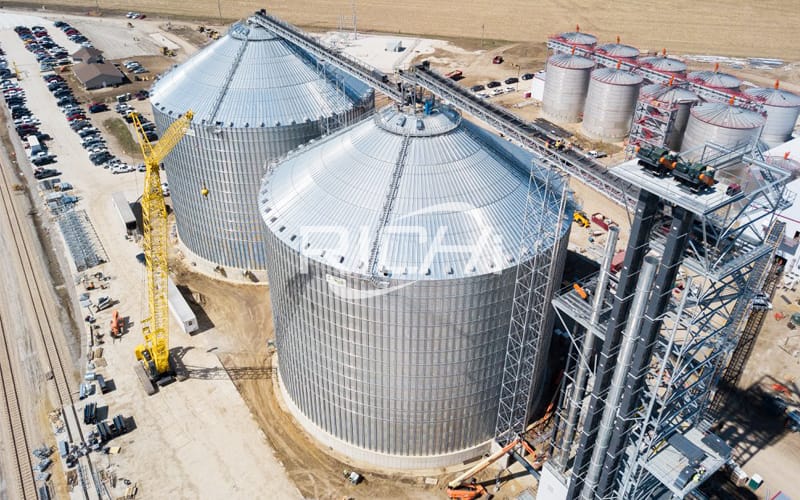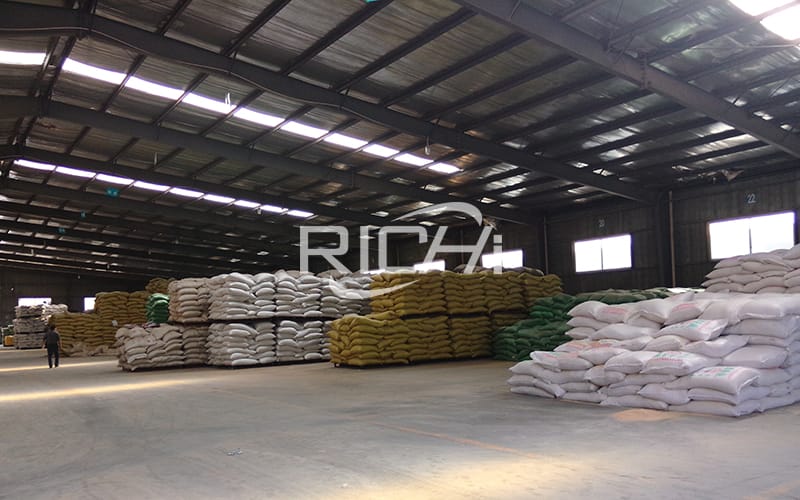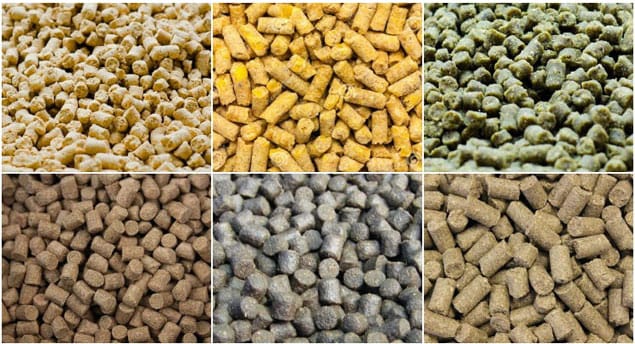Quality changes and protection measures in the storage and processing of feed ingredients
In today's livestock and poultry production, producers and nutritionists have paid great attention to dietary energy levels, amino acid quality concentrations and proportions, and the best supply of vitamins and trace elements. It is very important for livestock and poultry farms to benefit from selecting feed materials with suitable price, good quality and easy storage, and using appropriate raw material processing methods to prepare animal feed. However, the storage and processing technology of feed materials also have some problems that need attention. Good feed storage and processing practices are often overlooked. The article will discuss the impact of storage conditions and processing technology on the nutritional value of feed ingredients and how to prevent quality changes of feed ingredients.

1. The concept and source of feed ingredients
Feed raw materials refer to feeds derived from an animal, plant, microorganism or mineral in feed processing. Feed ingredients include 11 varieties of soybeans, soybean meal, corn, fish meal, amino acids, miscellaneous meal, additives, whey powder, oil, meat and bone meal and grains. In my country, formulas are formulated in accordance with the national standard content of feed ingredients. Even though each feed company formulates formulas in accordance with the standards, due to geographical differences and climate differences, the feed formulas vary greatly, even if it is the same feed.
Due to different processing methods and varieties, its nutritional content will also be different, even if the source of the feed ingredients are the same, the formula is the same, but due to the inconsistent processing conditions, there will be great differences between different batches. The prerequisite for the maximum growth potential of animals is the nutrient level of the feed formula. The nutrient level of the feed formula is determined by the nutrient content of the feed ingredients. Therefore, it is necessary to formulate a reasonable feed formula and select appropriate ingredients according to different regions. A reasonable feed formula will bring greater economic benefits to farmers.
2. Selection and storage of raw materials
The selection and preparation of feed ingredients are the key to determining the quality of feed. The feed is formulated according to the animals to be fed. Different animals require different feed nutrients. For example, when preparing pig feed, attention should be paid to mold and protease inhibition. Anti-nutritional factors such as drugs are potentially harmful to pig growth. When preparing fish and shrimp feed, high-protein feed materials are required, and toxic substances in feed materials must be strictly eliminated. When storing feed ingredients, special attention should be paid to unnecessary pollution caused by the external environment, which may cause mold and mycotoxin production. Therefore, proper storage methods must be selected in actual production to ensure the quality of feed ingredients.
In recent years, feed ingredients are facing a shortage situation. In order to improve efficiency, producers have adulterated raw materials. This has brought harm to feed production, making enterprise personnel strictly control inspections on raw material reserves and inspect purchased raw materials Whether it meets the national feed quality standards, choose the correct raw materials, ensure the safety of feed production, and prevent adulterated feed from entering the warehouse. Furthermore, due to the limitations of current feed testing equipment, some feed companies have not tested pesticide residues and contaminated raw materials. Therefore, this has become a major hidden danger in feed production safety and should be paid enough attention to by the feed industry to benefit feed. The development of the industry brings benefits to the breeding industry.
3. Raw material processing
In the process of feed raw materials processing, small impurities in feed are often ignored by producers. Because these small impurities contain complex components, they will become a breeding place for harmful microorganisms, and the raw materials can be used as the culture medium to make harmful microorganisms fast Growth, produce a lot of harmful substances, and deteriorate feed quality, which is also a problem in feed production. In feed production, the removal of small impurities is conducive to feed safety.
Many factors in the feed processing technology can cause the residue of toxic substances in the feed, the most important of which is the feed production process design, feed machinery manufacturing and work accuracy. In production, if corresponding measures can be taken in the selection of equipment and process design, the residues of hazardous substances can be reduced. Such as screw conveyors and scraper conveyors, these equipment will have residues due to structural reasons, so when designing these equipment, it should have design requirements that can make materials easy to enter and easy to clean. Some feed production needs to be equipped with a suction and dust removal system, and an independent air network is set up. For example, the production of compound premixes with added drugs must undergo such treatment, so that the feed will not cause secondary pollution.

4. Changes of main nutrients in feed ingredients during storage
(1) Sugars
The feed ingredients are mainly grains, which contain a lot of starch, so starch is the main sugar in the feed ingredients. The starch in the feed is digested and used by being decomposed into dextrin and fructose under the action of α and β amylases. of. Therefore, in a high temperature environment, sugars will be fermented, ethanol and acetic acid will be produced, which will make the feed sour, change the original flavor of the feed, and reduce the nutritional value of the feed. In addition, during the storage process, when the relative humidity of the environment is 75% or greater than 75%, the activity of amylase is enhanced, resulting in starch being hydrolyzed. Due to the hydrolysis of amylase, the water content is increased, and the sugar in the feed is also reduced. Decomposed into carbon dioxide and water, reducing the sugar content in the feed, thereby reducing the dry matter content in the feed.
(2) Protein
During storage, the quality of crude protein in feed ingredients will hardly change significantly. Because the nitrogen-containing mixture changes more slowly than other components, it is not easy to lose from the feed, and may sometimes increase slightly due to the reduction of sugars. But over time, the solubility and digestibility of protein will decrease. In addition, when feed ingredients are contaminated by mold, mycotoxins are produced. The most common thing in life is that the feed is contaminated by Aspergillus flavus to produce aflatoxin, which deteriorates the quality of feed ingredients. There are also some common feed ingredients, such as fish meal, feather meal and blood meal, which are easily contaminated by E. coli and Salmonella, severely reducing the quality of feed ingredients and causing serious harm to animals. Therefore, in order to ensure the quality of feed, the selection and preservation of raw materials is very important.
(3) Fat
Some feeds contain high fat content, such as oil cakes and peanut cakes. These fats are easily oxidized and decomposed automatically, produce peculiar smells, and also destroy fat-soluble vitamins and reduce the nutritional value of feeds. To prevent feed oxidation, anti-oxidants are generally added Oxidants, antioxidants are divided into natural antioxidants and synthetic antioxidants, natural antioxidants such as cloves, pepper and fennel, etc., these are effective for feed safety and prevent fat deterioration, and are pollution-free and have no adverse reactions. The most commonly used synthetic oxidant is ethoxyquin, etc., and the effect is better. When the storage temperature and humidity increase, the ability of lipase to decompose will increase, which will quickly cause the feed to spoil. This is also due to the fact that molds multiply under high humidity and high temperature conditions to produce mycotoxins and increase the activity of lipases. Therefore, the change in fat content during storage is also determined by the storage temperature and humidity. As long as the storage environment is suitable, fat loss will be reduced.
(4) Minerals and vitamins
In addition to carbohydrate and protein, feed ingredients are also rich in minerals and vitamins. When minerals are stored, except for special conditions, usually their content will not change. Vitamins will be lost during storage. The fat-soluble vitamins in the feed will change with changes in environmental conditions. For example, the pigment content will change greatly due to temperature, light, humidity, storage period and mildew. Taking alfalfa as an example, under the condition of -9 to 15%, about 10% of carotene is lost during the half-year storage period. At room temperature, the loss is 60% to 75%. If it becomes moldy, it will lose 98% in the short term. The largest loss of feed ingredients during storage is vitamin E. When stored in an aerobic environment for 190 days, the loss is about 62% to 67%. In addition, vitamin A and vitamin D are also easy to reduce the potency due to oxidation.

5. Measures to protect the quality of feed ingredients
(1) Control the moisture content of incoming raw materials
Moisture is an important indicator for the safe storage of feed ingredients. High moisture content can easily cause mold and insect pollution, produce large amounts of mycotoxins, deteriorate feed quality, and cause livestock and poultry diseases. Under normal circumstances, when the moisture is below 10% to 13%, it can inhibit the production of most microorganisms and insects. Of course, due to economic reasons, many raw materials cannot be processed to a very dry level. Therefore, the moisture content of the incoming raw materials must be strictly controlled. In addition, if the moisture content is too high, the raw materials will be easily contaminated by mold during storage. The use of anti-mold agents to control mold growth is also an effective measure. Controlling mold growth can reduce mycotoxin production. However, the anti-mold agent cannot remove the existing mycotoxins in the raw materials, so mold control measures must be formulated as early as possible before mold contamination occurs.
(2) The feed material warehouse should be ventilated, dry and protected from light
Ventilation, dryness, and protection from light are the conditions that the feed material warehouse should have. The rapid growth of mold is affected by temperature and humidity. When the temperature and humidity are too high, molds will quickly multiply and breed, and produce a large amount of mycotoxins. , Deteriorating feed quality. Therefore, the humidity in the feed material warehouse should be controlled below 65%. Avoiding light is to ensure that the nutrients of feed are not destroyed. Studies have shown that light can catalyze changes in feed quality. Light can cause fat oxidation, destroy fat-soluble vitamins, and protein will also change due to light. Therefore, feed ingredients should be avoided. Light save. In order to reduce the moisture content in the warehouse, some effective measures can be taken to change it, such as storage methods and warehouse design.
(3) Disinfection and pest control
The raw materials stored in the warehouse are easily contaminated by insects. In addition to biting on contaminated feed, insects can also increase temperature and humidity. Insects are very sensitive to temperature changes. The most suitable temperature for insect reproduction is about 29℃ , The life cycle of insects is about 30 days, and they reproduce very quickly. When the temperature is lower than 15.5°C, the reproduction is very slow or even stops. When the temperature is as high as 41°C or higher, it is difficult to grow and reproduce, and it is almost non-existent. Therefore, the insects must be regularly exterminated to ensure the feed storage period. Microorganisms are also a way to contaminate feed materials.
For example, some feed materials are easily contaminated by microorganisms, such as animal protein feeds such as silkworm pupa, meat and bone meal, fish meal and bone meal. Formaldehyde solution can be used regularly for these raw materials that are easily contaminated and invaded by microorganisms. Add potassium permanganate for airtight fumigation, which can achieve preventive and insecticidal effects. This type of protein feed is generally not used in large amounts, and can also be stored in plastic bags. In order to prevent damp heat and mildew, put it in a plastic bag and seal it tightly. Place it in a dry and ventilated place. Check the temperature frequently during storage. If there is heat, Phenomenon should be dealt with in time.
(4) Keep the grease tightly closed and add antioxidants
As an energy feed material, fats and oils contain very high unsaturated fatty acids and are prone to oxidation. In order to prevent oxidation and rancidity during storage, we must first find out the main cause of oxidative rancidity. Studies have shown that: The reason why oil is easily oxidized, rancidity occurs because of changes in environmental conditions, such as changes in light, temperature and humidity, will cause its oxidative rancidity. Oil and fat feed ingredients have high protein, vitamin and fat content, and their surface has no protective layer. When there is strong light, it will quickly oxidize and become rancid under high temperature and humidity. Therefore, protection from light, low temperature and low humidity is also one of the main measures to prevent the deterioration of fat feed ingredients. In addition, antioxidants can be added to some fat feed ingredients to prevent oxidation, which is also an effective method.
(5) Maintain the particle size integrity of feed ingredients
For some granular feeds, in order to avoid the loss of nutrients in the feed during storage, it is necessary to maintain the integrity of their particle size and do not pass through crushing or sieving, because the higher the crushing degree, the more serious the loss of nutrients. Maintain its own characteristics, so that its own nutrients, such as protein, vitamins and fat content will not change. It also better guarantees the safety of feed production and provides a guarantee for the healthy growth of livestock and poultry animals.
If you have the following questions, welcome to consult Richi Machinery:
feed pellet mill for sale australia
leading poultry feed mill business plan pdf
animal feed processing plant florida
operating system controls pellet mill cp
livestock feed plant factory management positions
positive impact of compound animal feed processing plant
animal feed processing methods pdf
feed mill for sale in australia
largest animal feed plant in italy
feed pellet press price in europe
If you want to built one complete pellet production line in your country, pls send the inquiry to us. We will customized design according to your requirement.



